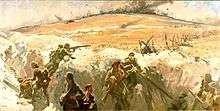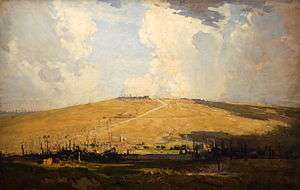Battle of Mont Saint-Quentin
| ||||||||||||||||||||||||||
The Battle of Mont Saint-Quentin was a battle on the Western Front during World War I. As part of the Allied counteroffensives on the Western Front in the late summer of 1918, the Australian Corps crossed the Somme River on the night of August 31, and broke the German lines at Mont Saint-Quentin and Péronne. The British Fourth Army's commander, General Henry Rawlinson, described the Australian advances of August 31 – September 4 as the greatest military achievement of the war.[1] During the battle Australian troops stormed, seized and held the key height of Mont Saint-Quentin (overlooking Péronne), a pivotal German defensive position on the line of the Somme.
Background
The Allies were pursuing the Germans, and the greatest obstacle to crossing the Somme River in pursuit was Mont Saint-Quentin which, situated in a bend of the river, dominated the whole position. The Mont was only 100 metres high but was a key to the German defence of the Somme line, and the last German stronghold. It overlooked the Somme River approximately 1.5 kilometres north of Péronne. Its location made it an ideal observation point, and strategically, the hill's defences guarded the north and western approaches to the town.[2]
Australian forces faced the German 51. Korps, part of 2. Armee, under General Max von Boehn. According to Australian official historian Charles Bean, "German archives show that the 51st Corps anticipated the offensive... The line divisions were ordered to increase their depth and the counter-attack divisions to 'stand to.'"[3] Bean states that 51. Korps controlled the 5th Royal Bavarian Division, 1st Reserve Division and 119th Division. The German 94th Infantry Regiment (part of 4. Reserve-Korps) was also involved in the battle.
Battle

The offensive was planned by General John Monash; Monash planned a high-risk frontal assault which required the Australian 2nd Division to cross a series of marshes to attack the heights. This plan failed when the assaulting troops could not cross the marshes. After this initial setback, Monash manœuvred his divisions in the only free manœuvre battle of any consequence undertaken by the Australians on the Western Front.[4]
.jpg)
Australians of the Second Division crossed to the north bank of the Somme River on the evening of 30 August. At 5 am on 31 August 1918, supported by artillery, two significantly undermanned Australian battalions, charged up Mont St Quentin ordered by Monash to 'scream like bushrangers'. The Germans quickly surrendered and the Australians continued to the main German trench-line. In the rear, other Australians crossed the Somme by a bridge which Australian engineers had saved and repaired. The Australians were unable to hold their gains on Mont St Quentin and German reserves regained the crest. However, the Australians held on just below the summit and next day it was recaptured and firmly held. On that day also, 1 September 1918, Australian forces broke into Péronne and took most of the town. The next day it completely fell into Australian hands. In three days the Australians endured 3,000 casualties but ensured a general German withdrawal eastwards back to the Hindenburg Line.[5]
Aftermath
Looking back after the event, Monash accounted for the success by the wonderful gallantry of the men, the rapidity with which the plan was carried out, and the sheer daring of the attempt. In his Australian Victories in France, Monash pays tribute to the commander of the 2nd Division, Major-General Charles Rosenthal, who was in charge of the operation. But Monash and his staff were responsible for the conception of the project and the working out of the plans.[6]
The Allied victory at the Battle of Mont Saint Quentin dealt a strong blow to five German divisions, including the German elite 2nd Guards Division. As the position overlooked much of the terrain east of Mont St. Quentin, it guaranteed that the Germans would not be able to stop the allies west of the Hindenburg Line (the same position from which the Germans had launched their offensive in the spring). A total of 2,600 prisoners were taken at a cost of slightly over 3,000 casualties.[7]
The following soldiers were awarded the Victoria Cross for their role in the battle, all to members of the Australian 2nd Division:
- Albert David Lowerson, 21st Battalion, originally from Myrtleford, Victoria
- Robert MacTier, 23rd Battalion, originally from Tatura, Victoria
- Edgar Thomas Towner, 2nd Machine Gun Battalion, from Blackall, Queensland
Other medals awarded included the Military Medal. Robert James Young, 25th Battalion, originally from Brisbane, was one such awardee. During the attack "he selected a position on a hill which was being heavily shelled at the time. He remained there for half an hour trying to establish visual communication. When this failed, he at once ran at a line to bde Forward Station through very heavy machine gun and artillery fire and remained out on the line the whole day, keeping it in order. Throughout the whole operation he showed an utter disregard of danger and set a fine example to all his men." - C.Rosenthal, Major General, 11/9/18
William Stevens, 23rd Australian Infantry Battalion, originally from Melbourne was awarded a Bar to his Military Medal for his work during the battle. In part, his citation from C.Rosenthal, Major General reads: "In the Village fighting he personal lead a party of five which accounted for 16 of the enemy who put up a spirited resistance. Later during the consolidation, he personally supervised the placing of the six Company Lewis Guns, moving around the Company front in spite of fierce enemy fire. His work throughout was of the highest order, and his fighting spirit throughout was of the greatest value to the success of his Company."[8]
See also
References
- ↑ "Mont Saint Quentin and Péronne". Australian Victories: 1918 Australians in France. Australian War Memorial. Archived from the original on 7 August 2007. Retrieved 2007-08-31.
- ↑ "The Battle for Mont St Quentin: 31 August 1918 – 3 September 1918". Penrith City Council Library Service, Penrith City Council. 2005. Archived from the original on 8 September 2007. Retrieved 2007-08-31.
- ↑ C. E. W. Bean, 1942, Official History of Australia in the War of 1914–1918 - Volume VI – The Australian Imperial Force in France during the Allied Offensive, 1918, Sydney, Angus and Robertson, pp916–7.
- ↑ Fidge, AC. 2003. Sir John Monash – An effective and competent commander?. Australian Defence College, Geddes Papers
- ↑ "Mont St Quentin – Péronne 31 August – 2 September 1918". Australians on the Western Front 1914–1918. Australian Government: Department of Veterans' Affairs together with Board of Studies NSW. 12 February 2008. Archived from the original on 25 July 2008. Retrieved 2008-08-18.
- ↑ Serle, Percival (1949). "Monash, John". Dictionary of Australian Biography. Sydney: Angus and Robertson.
- ↑ "Mont St Quentin". Western Front. www.diggerhistory.info. Archived from the original on 30 September 2007. Retrieved 2007-08-31.
- ↑ https://www.awm.gov.au/images/collection/pdf/RCDIG1068292--104-.pdf
External links
| Wikimedia Commons has media related to Battle of Mont St. Quentin. |
- "Mont St Quentin: Australian Military Units". Australian War Memorial. Archived from the original on 11 September 2007. Retrieved 2007-08-31.
- "Mont St Quentin, 2nd Australian Division Memorial". Australians on the Western Front: 1914–1918. Australian Department of Veteran's Affairs and Board of Studies NSW. 2007. Archived from the original on 2007-09-03. Retrieved 2007-08-31.
